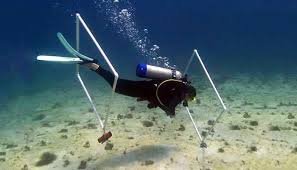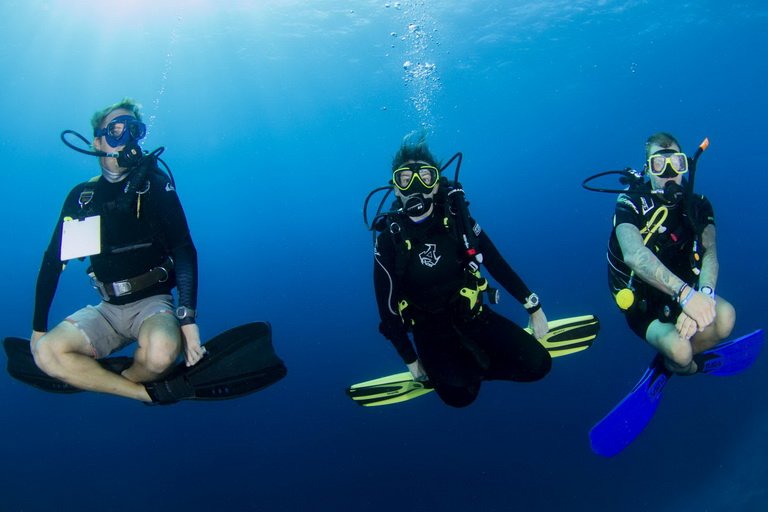During the PADI Peak Performance Buoyancy course, divers learn various techniques and strategies to achieve optimal buoyancy control. The course begins with a classroom session where divers are introduced to the basic principles of buoyancy and the importance of mastering this skill for safe and enjoyable diving. Divers also learn about the different factors that affect buoyancy, such as body position, breathing, and equipment configuration.
Once the theoretical foundation is established, divers move on to the practical aspect of the course. They start by performing buoyancy checks and adjusting their weights and equipment to achieve neutral buoyancy. This involves finding the perfect balance between positive buoyancy (floating) and negative buoyancy (sinking) so that divers can maintain their desired depth effortlessly.
Throughout the course, divers practice different buoyancy control techniques, including proper finning techniques, efficient breathing, and body positioning. They also learn how to use their breath to control their ascent and descent rates, allowing for smooth and controlled movements in the water column.
One of the key components of the PADI Peak Performance Buoyancy course is the use of buoyancy control devices (BCDs). Divers learn how to use their BCDs effectively to fine-tune their buoyancy and maintain a stable position in the water. They also learn how to control their buoyancy without relying solely on their BCDs, using their breath and body movements to make precise adjustments.
By the end of the course, divers should have a solid understanding of buoyancy control and be able to maintain a stable position in the water column with minimal effort. They will have developed the skills necessary to conserve energy, improve air consumption, and avoid damaging the delicate marine environment.
environment.
The PADI Peak Performance Buoyancy course is not only beneficial for novice divers but also for experienced divers looking to enhance their buoyancy control skills. It is a valuable course that can greatly improve the overall diving experience and open up new opportunities for exploration and enjoyment underwater.
What is Involved in PADI Peak Performance Buoyancy?
The PADI Peak Performance Buoyancy course is designed to help divers fine-tune their buoyancy control and achieve a higher level of comfort and confidence in the water. The course typically consists of a combination of knowledge development sessions, confined water dives, and open water dives.
Knowledge Development
During the knowledge development sessions, divers will learn about the principles of buoyancy, including the effects of weight distribution, breathing techniques, and equipment configuration on buoyancy control. They will also be introduced to various techniques and skills that can help them improve their buoyancy, such as proper weighting, trim, and body positioning.
Furthermore, divers will gain an understanding of the importance of buoyancy control for the environment. They will learn how improper buoyancy can damage underwater ecosystems and disturb marine life. By understanding the impact of their actions, divers can become more responsible and conscientious underwater explorers.
Confined Water Dives
The confined water dives provide an opportunity for divers to practice and refine their buoyancy skills in a controlled environment, such as a swimming pool. Under the guidance of a PADI instructor, divers will perform various exercises and drills to improve their buoyancy control, such as hovering at different depths, swimming through hoops without touching them, and maintaining neutral buoyancy while performing other tasks.
These confined water dives also allow divers to become familiar with their equipment and make any necessary adjustments. They will learn how to properly adjust their weight system, regulate their breathing, and position their body to achieve optimal buoyancy. By practicing these skills in a controlled setting, divers can build confidence and muscle memory before venturing into open water.
Open Water Dives
Once divers have mastered the basic buoyancy skills in confined water, they will move on to the open water dives. These dives allow divers to apply their newly acquired skills in a real-world diving environment. They will have the opportunity to explore underwater sites while focusing on maintaining neutral buoyancy, conserving air, and minimizing their impact on the underwater ecosystem.
During the open water dives, divers will encounter various challenges that will test their buoyancy control. They may need to navigate through tight spaces, swim against currents, or interact with marine life. By applying the techniques and principles learned during the course, divers can navigate these situations with ease and confidence.
Furthermore, the open water dives provide divers with the chance to appreciate the beauty and diversity of the underwater world. They will have the opportunity to observe marine life up close, explore underwater formations, and experience the tranquility of being submerged in nature. These dives can be both educational and awe-inspiring, leaving divers with a deeper appreciation for the importance of buoyancy control and responsible diving practices.
Increased Dive Duration
One of the significant advantages of mastering buoyancy control through the PADI Peak Performance Buoyancy (PPB) course is the ability to extend dive durations. When divers can maintain neutral buoyancy, they are less likely to exert unnecessary energy and can conserve air more efficiently. This means they can stay underwater for longer periods, exploring the underwater world and enjoying their dives to the fullest.
Extended dive durations are particularly beneficial for divers who are passionate about underwater photography, videography, or conducting scientific research. These activities often require more time underwater to capture the perfect shot or collect data. By honing their buoyancy skills through the PPB course, divers can maximize their time underwater and make the most of these specialized activities.
Improved Dive Planning and Execution
The PPB course also equips divers with the knowledge and skills to plan and execute dives more effectively. Understanding buoyancy control allows divers to factor in their air consumption rate and adjust their dive plans accordingly. They can better estimate how long they can stay at a specific depth, how much air they will need, and when to begin their ascent to ensure a safe and enjoyable dive.
Furthermore, divers who have mastered buoyancy control are more likely to be aware of their surroundings and potential hazards. They can navigate through tight spaces, swim through currents, and maneuver around obstacles with confidence and ease. This level of control and situational awareness enhances the overall dive experience and reduces the likelihood of accidents or incidents occurring during the dive.
Confidence and Self-Reliance
By completing the PPB course and gaining mastery over buoyancy control, divers develop a sense of confidence and self-reliance in their diving abilities. They no longer have to rely solely on their dive guides or buddies for assistance in maintaining proper buoyancy. Instead, they can independently adjust their buoyancy to adapt to different diving conditions and scenarios.
This increased confidence and self-reliance not only enhance the diver’s overall enjoyment but also contribute to their safety. Divers who are confident in their buoyancy control skills are less likely to panic or become disoriented underwater, as they have the necessary tools to handle challenging situations. They can focus on exploring and appreciating the underwater world without unnecessary distractions or concerns.
Personal and Professional Development
The PPB course offers divers an opportunity for personal and professional development. By investing time and effort into mastering buoyancy control, divers demonstrate their commitment to becoming skilled and responsible divers. This dedication to continuous learning and improvement can open doors to new diving opportunities, such as participating in advanced diving courses or pursuing careers in the diving industry.
Beyond the diving realm, the skills developed through the PPB course, such as discipline, focus, and attention to detail, can be transferred to various aspects of life. These skills can contribute to personal growth and success in other areas, fostering a well-rounded individual.
In conclusion, the PADI Peak Performance Buoyancy course offers numerous benefits for divers of all experience levels. From improved control and comfort in the water to enhanced safety, environmental awareness, and opportunities for continued learning and growth, mastering buoyancy control through the PPB course is a valuable investment in a diver’s skills and enjoyment of the underwater world.
